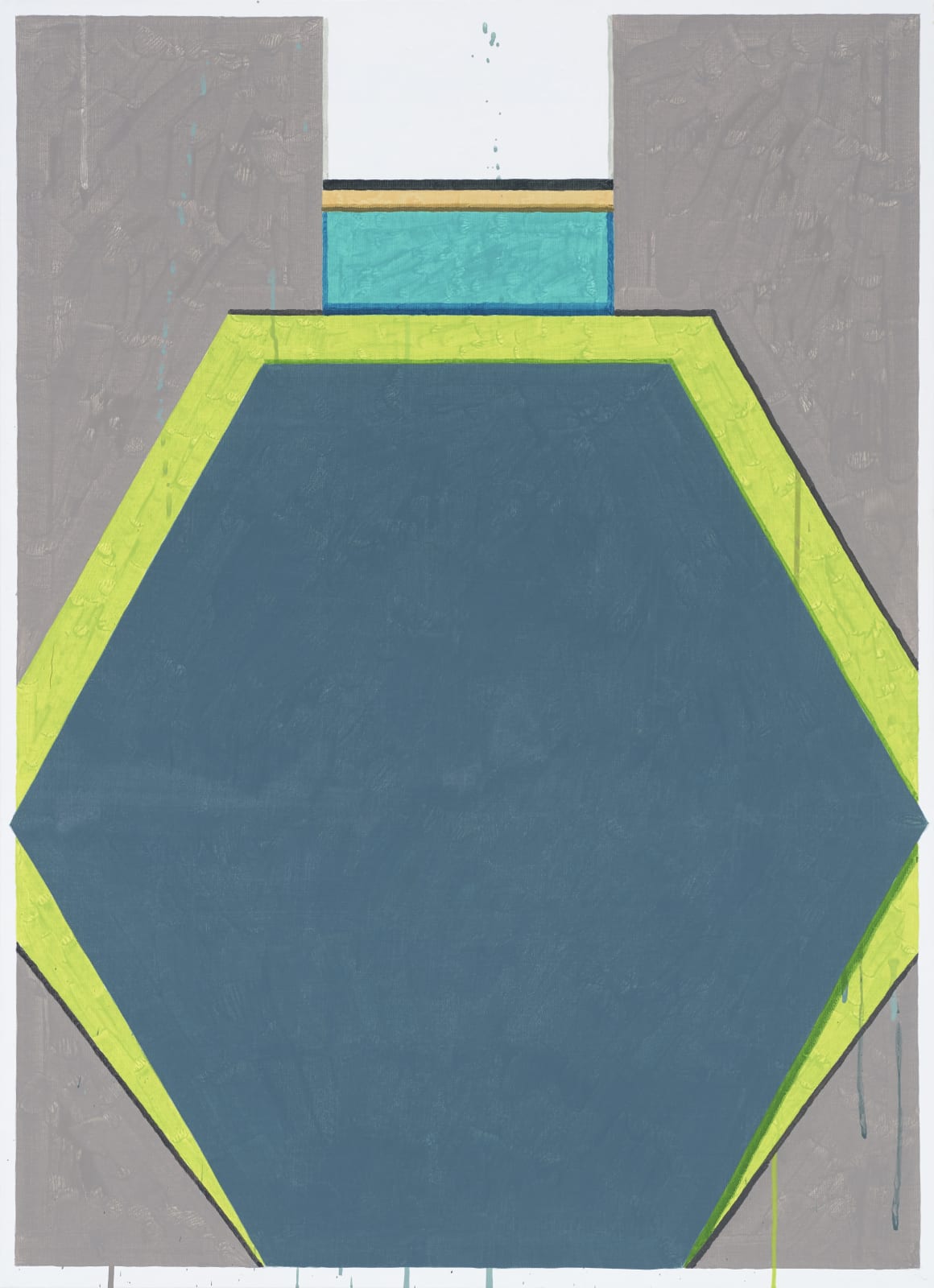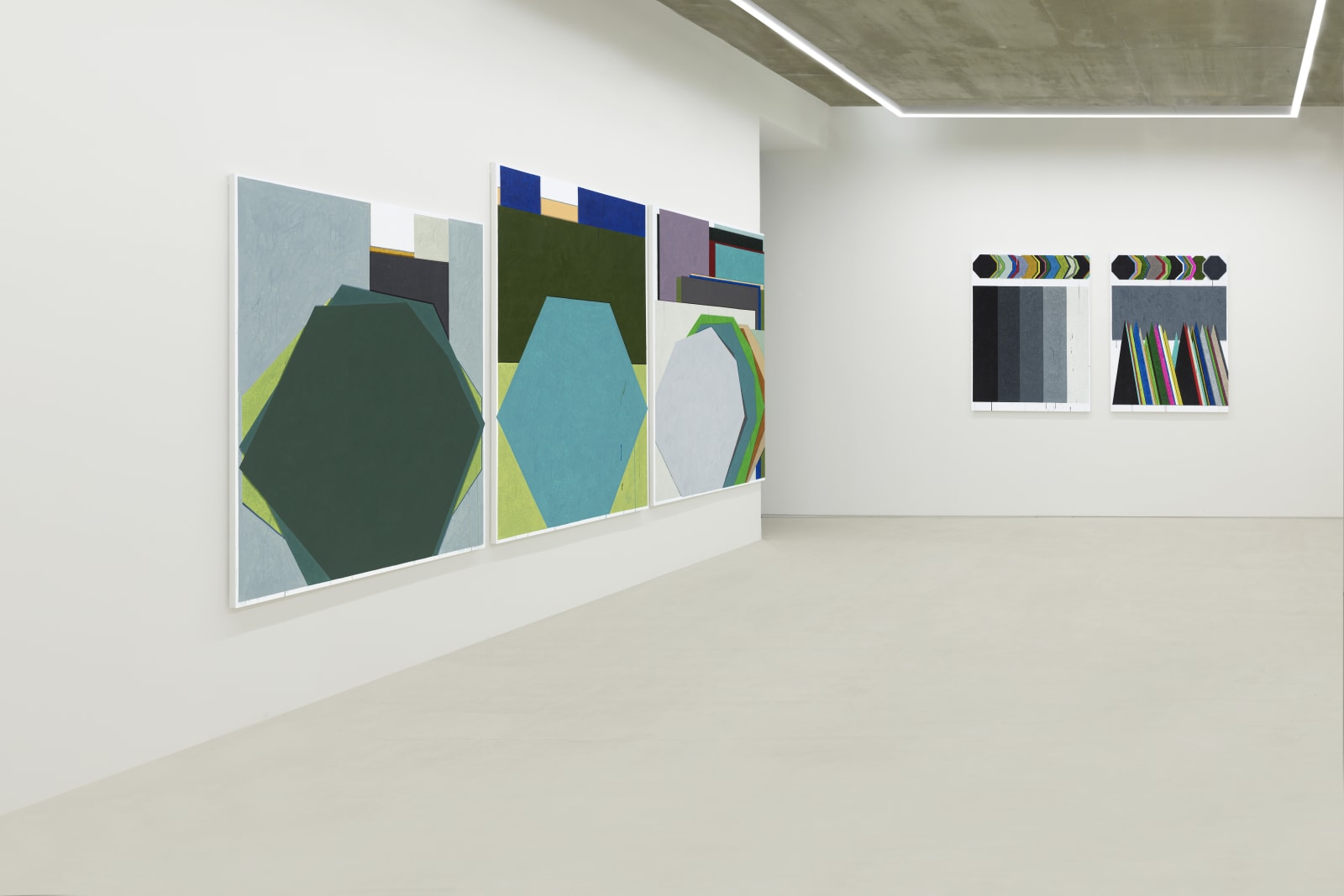검은 녹색 입: 전현선 Hyunsun Jeon
전현선의 이전 작업은 ‘어떠한’ 이야기를 상상하게 하는 그림이었다. 구체적으로 서술하지는 않지만, 자신이 경험한 일을 기록하는 데서 그림이 시작되었다. 나와 내가 아닌 모든 것 사이의 갈등과 오해, 낯섦과 미묘한 긴장감은 인물과 사물의 형상 안에 혹은 그것들 사이의 배치를 통해 전달됐다. 그의 그림은 사건의 묘사가 아닌 기류의 묘사인 것이다.
미묘한 공기의 흐름을 담은 그림에 불쑥 등장하는 원뿔은 관자의 눈을 현혹하고, 이야기의 방향 전환을 유도한다. 영상의 음소거 기능과 같은 원뿔은 이야기에 몰입하려는 이들을 방해한다. 형상으로 번역되지 못한 기류, 답이 없는 문제는 원뿔로 변해버린 것이다. 나와 내가 아닌 모든 것 사이의 문제들을 어떻게 다 설명할 수 있겠는가! 원뿔은 말이나 형상으로 설명되지 않는 ‘무언가’의 정체를 가리키는 동시에 그것의 정체를 감춰주는 이중의 역할을 한다.
2016년, 한 전시를 위한 다른 작가와의 공동 작업은 전현선에게 전환점이 된다. 공동 작업 이후 그는 이야기가 삭제된 그림을 그리고 싶었다고 한다. 작업을 위해 이야기를 설정하고 상황을 묘사하는 것이 자신에게 큰 과제였으며, 여기서 원뿔은 언제나 결정적인 역할을 해왔다고 말한다. 뿔은 이야기의 종결을 지연시키는 장치로서 그림의 입구이자 출구였기 때문이다. 이야기가 삭제되면 원뿔이 가진 상징성과 역할도 사라지게 된다. 마법이 풀린 원뿔은 작가가 그려내는 여러 형상 중 하나일 뿐이다. 이제 그가 그려내는 기하학적인 도형은 각별하면서도 각별하지 않은 존재가 됐다.
이번 개인전에서 작품은 현실에서 빌려온 구체적인 대상이 사라지고 기하학적인 색면 도형들로 가득하다. 추상화라고 부를 수 있는 그림이다. 그러나 전현선의 그림은 구상 혹은 추상이라는 어떤 자리에도 붙들어 놓을 수 없는 그림이다. 그는 도형을 그려내면서 하나의 구체적인 대상을 상상했다고 한다. 색지를 묘사한다는 마음으로 그린 것이다. 색지를 닮게 그려낸다는 것은 사실 언어도단이다. 실재의 대상을 묘사할 때, 그림은 언제나 원본과 비교된다. 그림에 있어 실재는 절대 이길 수 없는 존재이다. 색지를 그린다는 것은 맞을 것도 틀릴 것도 없으며, 화가가 실재의 대상과 닮게 그려냈는지 걱정할 필요가 없다는 것이다.
이 무정한 그림에서 우리가 포착해야 할 부분은 어쩌면 검은 선일지 모른다. 도형과 도형 사이에 슬쩍 그려진 검은 선은 그림자를 연상시킨다. 검은 선이 만들어낸 공간감은 그 깊이가 너무 얕아서 화면의 평면성을 모두 몰아내지는 못한다. 이것은 도형과 도형을 구분 짓는 경계선이자 추상과 구상의 구분을 모호하게 하는, 종결을 미루는 ‘원뿔’이다.
전현선은 추상이지만 구상인, 구상이지만 추상인 그림을 그리고 싶었다고 한다. 대립되는 성격의 두 요소를 한자리에 불러 놓은 것이다. 추상도 구상도 아닌 그의 그림은 명확한 결론을 제시하지 않고, 의미를 고정시키지 못하게 한다. 구체적인 대상의 옷을 입은 이야기와 기하학적인 원뿔 사이의 갈등과 포옹을 반복하는 이전의 작업과 다름이 없다. 상상 대 모방, 상징 대 감각, 지시 대 암시가 동시에 존재할 수 있는 곳은 원래 언어가 아닌 이미지의 자리이다. 그의 그림에서 대립하는 요소들은 시각적 조화 속에서 얽히고 용해된다.
그림이란 결국 해석돼야 하지만 전현선의 그림은 읽힐 수 없는 특징을 갖는다. 그는 ‘명확한 것은 그리고 싶지 않다’고 말한다. 너무 자명한 것은 그릴 필요가 없다고 생각하기 때문이다. 사라지게 되는 것, 사소한 것, 모호한 것을 위한 그림. 그 그림을 이해하기 위해서 우리는 먼저 그림의 벙어리 상태를 존중하는 법을 배워야 한다. 모든 이미지를 논리적으로 이해하고 언어로 설명하려는 것은 보는 것보다 읽는 것이 익숙한 사람들의 유식이 탈이다.
Hyunsun Jeon's previous works incited something of a story to the beholder. Although they did not provide detailed narratives, her past works were based on her record-keeping of personal experiences. Jeon's past works presented the strange and unknown otherness, even the conflict and misunderstanding between the self and all that is not the self, embodied by the figures and objects, or by the way they were composed and arranged within the frame. It is not an event she describes. It is an ambiance, an unfolding, an ongoing trail.
That faint ambiance is intruded upon by a cone, perplexing the gaze and stamps in a narrative pivot. Like the mute function on a media device, the cone interferes with immersion into the story. The unfolding trail that did not translate into visible form, those unanswered problems precipitated and crystallized into the form of a cone. How does one comprehend, much less explain the complexities between the self and everything that is not the self? Thus simultaneously, the cone is a placeholder for something that escapes visual description, and a blinder for what it might be.
A collaborative effort with another artist for a 2016 exhibition was a turning point for Jeon. The experience made her want to paint images removed of stories. Before then, establishing a story and delineating the context had been a constant challenge. It was here that the cone had a decisive role. It served as a mechanism that delayed the end of the story, both the point of ingress and egress. With the story removed, any symbolism or role of the cone is also removed. Divested of imagination and demystified, the cone is nothing but one of many forms painted on canvas. That is to say, the geometric forms painted by Jeon are both unique and ordinary.
Gone are the specific objects loaned from reality. This solo exhibition is filled only with colored geometric shapes. If anything, they might be called abstract. Yet Hyunsun Jeon paints in denial of both the concrete and the abstract. Even while her brush strokes painted geometric abstractions, her inner eyes were set on the concreteness of sheets of colored paper. Painting colored paper is rather nonsensical, as any description of an actual subject, an image describing an original thing, can only be compared to what it depicts, and it is bound to fall short of what it is seeks to depict. There is no right or wrong in painting colored paper. The painter need not worry if the painting resembles the actual.
Perhaps we ought to look deeper beyond the shapes and to the nonchalantly painted dark lines, drawn like shadowy boundaries between the shapes. The illusion of depth created by the shadows is too wispy to offer substance to the flatness of overall painting. The cone provides a sense of boundary between the geometrical shapes, while also blurring the lines between the concrete and the abstract, delaying anything conclusive.
Jeon explains that she sought to create images that were concretely abstract and abstractly concrete, like a chiral pair simultaneously present. Neither concrete nor abstract, the artist's paintings present no definitive conclusions, denying anchorage to any meaning. The cone is not far removed from her earlier works where identifiable subjects were in conflict within a definitive context of a story. The realm between the imaginary and imitated, symbolic and the sensed, dictated and the implied is that of the image, not language. Conflicting elements of the paintings are entangled and dissolved in visual harmony.
Imagery requires interpretation, but Jeon's paintings cannot be decoded, as she says "I do not wish to paint the obvious." She is not interested in painting the self-evident. To understand the ephemeral, the trivial, the obscure she puts on the canvas, we first need to learn how to appreciate its muted silence. Seeking logic and verbalizing every image when there ought to be none is sometimes the inexplicable behavior of one who would read before they see.








